| ← back |
Colonial Meetinghouses Featured in this Project |
next → |
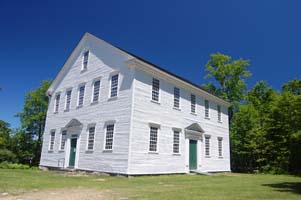 Name of Meetinghouse: Old Meeting House
Name of Meetinghouse: Old Meeting House
View on a mapStreet Address of Meetinghouse: near 40 Fremont Rd., Sandown NHYear(s) Built: 1773 National Register of Historic Places Designation: yes New Hampshire State Register of Historic Places: ? Organization responsible: Old Meeting House Historical Association Organization's address: 393 Main St., Sandown, NH 03873 Organization's web site: www.sandown.us Tax status: 501 (c)(3) tax exempt Contact: Arlene Bassett, 393 Main St., Sandown, NH 03873 Telephone: (603) 887-3453 E-mail: none This page was last updated on: June 15, 2009 Acknowledgements: The text below is taken from the book A View from Meeting House Hill by Richard Holmes, and has been used by permission. The entire chapter on the Old Meeting House can be read in its entirety by downloading this PDF file (8 Mb): A View from Meeting House Hill, Chapter 7.
The praise of outsiders, while always appreciated, is not the chief reason that the townspeople honor this building. To the residents of Sandown, this old building is the encapsulation of their town's entire history, for within its walls has passed the pageant of the community's past. For 155 years, the good men and women of Sandown gathered at this building to set their own taxes and to draft their own laws. This building was, to a great extent, the capitol of a small, semi-autonomous republic operating inside New Hampshire.
The term "meetinghouse" conveys a special meaning in the colonial period.
A church building, by definition, is primarily a house of worship, with any other function being secondary.
A meetinghouse, by contrast, is used for both secular and religious purposes on an equal basis.
Sandown's Old Meeting House would serve as a worship site on Sundays, but during the week might be utilized as a schoolhouse.
On some nights, the ladies' social circle would meet there; other times it would host a singing class.
On many Friday and Saturday nights, a dance and oyster supper would be held at the meetinghouse.
Thus, the building operated on several separate planes within the town: a religious chapel, a political meeting place, and a social function hall.
It was always considered the property of the town and never belonged to any religious denomination.
The first decision to be made in the process of building a new meetinghouse was where exactly should it stand.
Everyone wanted the meetinghouse in their own corner of the town and could give solid reasons why their particular neighborhood was deserving of the building.
All sides had visions of being able to roll out of bed on Sunday morning and walk five minutes to the chapel.
A political tug-of-war ensued.
Despite the fact that Meeting House Hill was a wonderful location for the new public building, it was, however, not the exact center of town.
The selection of the site was, in fact, a solution to a problem that the surveyors discovered on their safari.
The exact center of Sandown was, in reality, almost a half mile to the east - right in the middle of the Cranberry Meadow!
Apparently without asking the permission of anyone, the surveyors and the deacons just moved their line west to avoid the quaking swamp,
in those days before accurate maps, there was no one who was aware that truth was being adjusted to satisfy a changed situation.
To this day, it is still the accepted canon that the Old Meeting House is set on the exact center of the town.
It was the citizens of Sandown who did the muscle work of erecting the oak frame of the meeting house. However, the design and finishwork was most certainly not done by local workmen. Such fine craftsmanship, as is found in the pulpit and its sounding board, was probably the work of experts from the Salem-Amesbury, Massachusetts, area. A likely candidate for the artisan would be Timothy Palmer, the master builder who designed the 1785 Rocky Hill Meeting House in Amesbury, Massachusetts. A few houses in Chester, New Hampshire, contain molding details that are similar to Sandown's meetinghouse. This has led artisan Malcolm McGregor, Jr. to speculate that whoever did build the Old Meeting House worked in the area on a number of different projects over many years.
Another story claims that during the raising of the massive oak frame, the foreman shouted his directions so loud that his voice was hoarse for the rest of his life.
Anyone who has ever worked on a construction gang would acknowledge that this story could be true.
To frame a large building like the meetinghouse would require a high degree of coordination between all workers.
One man would have to stand to the side and shout directions so that everyone performed his tasks correctly and in unison with the others.
With an untrained crew, such as was the case in Sandown, the foreman could quite easily be very hoarse by day's end.
All was going well until the men discovered the rum barrel had run dry. A meeting of the workmen was quickly called. All were in agreement no rum, no work! The men laid down their tools and sat on the piles of timber. There they waited, refusing to do any more work.
All that afternoon and into the night, former Selectman Steven Batchelder drove a wagon and team along the dirt roads south to Newburyport, Massachusetts.
There he purchased another half barrel of good New England rum and, without pausing to rest, turned his team back to Sandown.
He arrived just at sunrise. With the liquor supply now replenished, the workers once more began to build the meetinghouse.
The building that was finally erected is a very impressive piece of work. It measures forty-four by fifty feet and stands a full two stories plus attic. Its frame consists of sixteen white oak posts, each a foot square. The interior surface of each post is left partially exposed like a medieval half-timbered building. The large attic has an extremely complicated series of king and queen post trusses which allows for the auditorium to be unobstructed by roof supports.
The meetinghouse has three doorways.
They each have delicately fluted pilasters on the sides of the casing and overhead triangular pediments.
The pilaster devises are also replicated in the interior of the building.
The dentil molding of the pendents are repeated in the roof cornices.
Scattered throughout the hall are 53 sheep-pen family pews.
All of the pews seem to have been built during the 1773-74 phase of construction, except for those in the center of the ground floor.
Surrounding each of the pews is a three-foot-high wall.
In this way, each worshipper is shut inside a little room set apart from his neighbor.
The reason for these walls and doors was primarily to serve as a draft-barrier during the long cold season.
The walls also allowed the children to play or sleep on the floor without being observed by the entire congregation.
Because each family legally owned its own pew, it may also be that the pew walls served as boundary markers
and thus were as reassuring to the pew owner as stone walls were to the landowner.
Additional seating in the meetinghouse was provided by a long double row of built-in plank benches along the east and west front edges of the balcony - one side was for the boys, the other for the girls. It can be imagined that the view across the balcony would be of more appeal than watching the pastor pounding his pulpit. At the north end of each of the benches is a small enclosed pew. These were the slave pews. The town never had a large slave population - probably never more than a very few at any given time - and so those pews never had much use.
As the visitor enters the building via the south door, he is immediately confronted by the sight of the great pulpit looming at the end of the grand alley. The tall pulpit is entered by climbing a narrow stairway of ten steps and then passing through a pew door. The pastor in the pulpit is 11 feet above the floor of the meetinghouse and almost at eye level with those in the balcony. The elevated pulpit assured that everyone could see the preacher and that there were no bad seats in the house.
Suspended from the ceiling high above the pulpit is an elaborate piece of woodwork called a sounding board.
This hemisphere of raised paneling was supposed to aid the acoustics of the building.
It is secured to the frame of the building by wrought-iron brackets and is 19 feet above the floor.
It is easy to imagine a child sitting in the congregation getting fidgety as the service goes into its second hour.
In his imagination, he changes the sounding board into a candle snuffer and down it comes and extinguishes the pastor.
For the first 50 years after 1774, there was no heat in the old building.
Those who demanded warmth during the cold season had to bring portable charcoal stoves, small, pierced tin boxes encased in a wooden frame.
Filled with hot coals right before the service, they might give off heat for over an hour.
According to legend, there was an outdoor fireplace in the meetinghouse yard where the worshippers could replenish their supply of hot coals at noontime.
The fact that the Old Meeting House has been so perfectly preserved is chiefly the result of benign neglect. The voters and their elected leaders have basically always left the building alone. They would maintain it, keep a roof on it, and slap a coat of paint on the clapboards but never vote any money for improvement. It is unknown if this hands-off policy was due to Yankee stinginess or because they wanted their meetinghouse left exactly the way their fathers had built it.
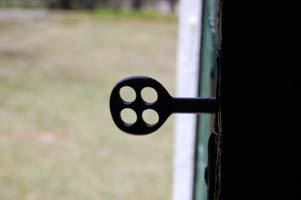
In 2007, the Old Meeting House was the setting for the video production The Colonial Meetinghouses of New England, produced by former Public Television cameraman Peter Hoving. This video features the meetinghouses of New England as portrayed by large-format photographer Paul Wainwright, and can be viewed by clicking: Media Gallery. |
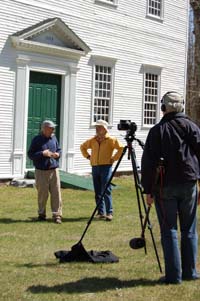
|
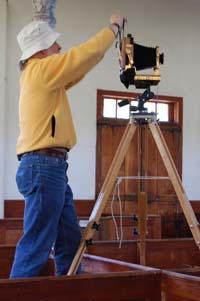
|
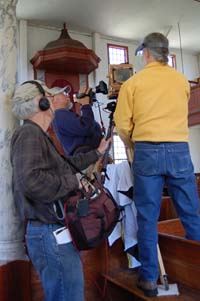
|
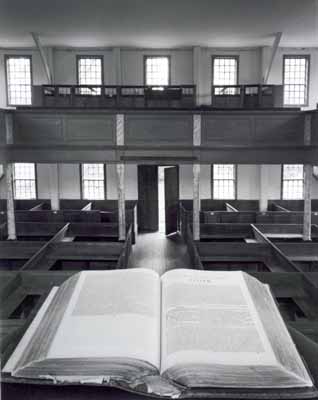
|
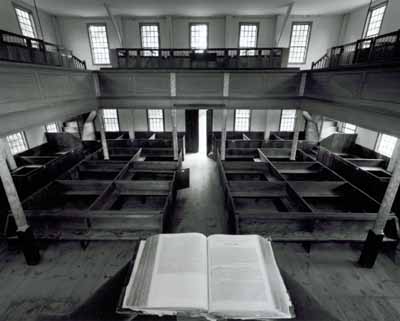
|
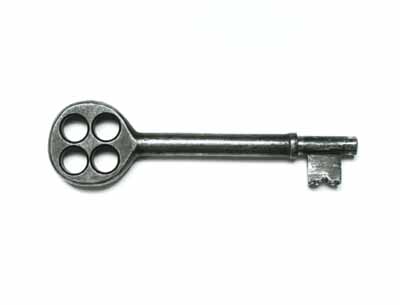
|
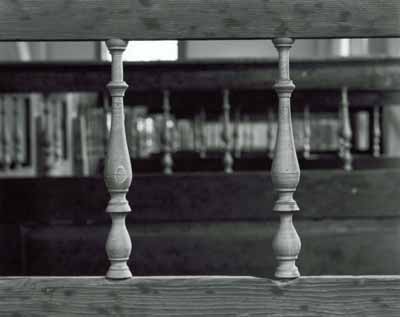
|
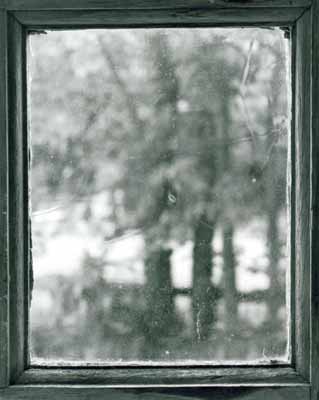
|
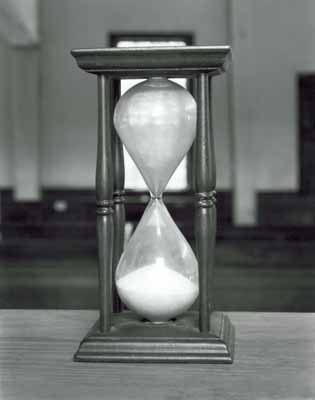
|
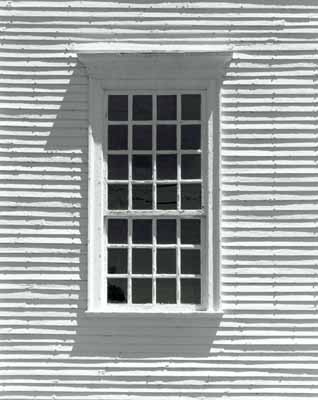
|
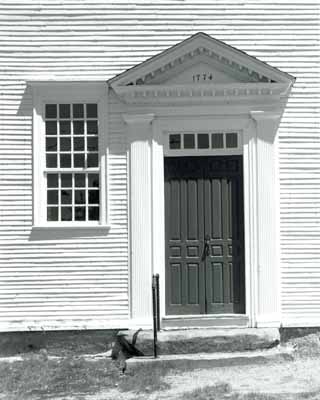
|
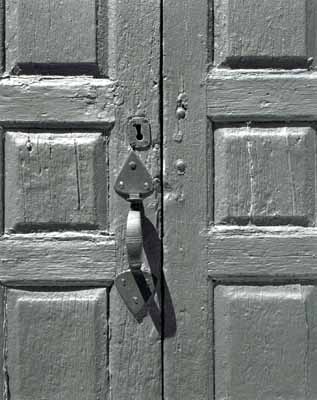
|
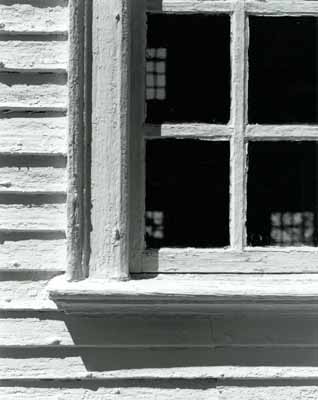
|
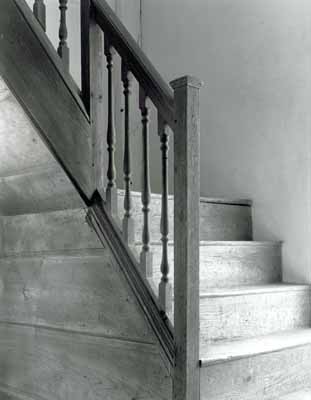
|
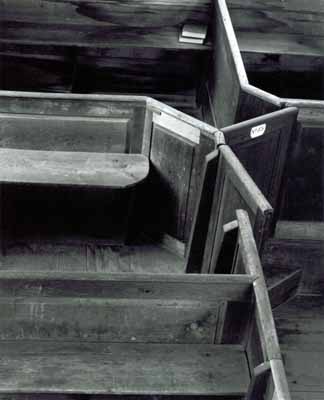
|
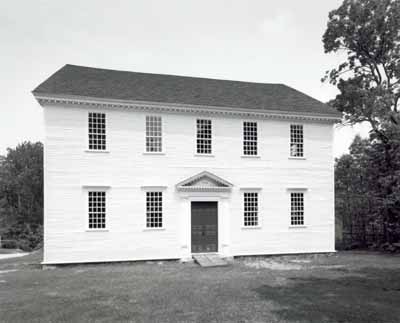
|
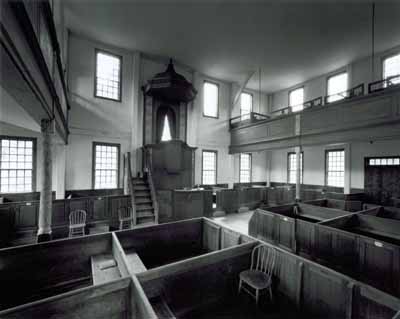
|
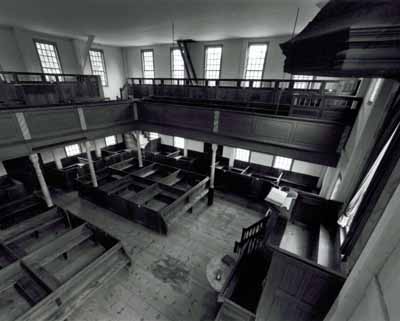
|
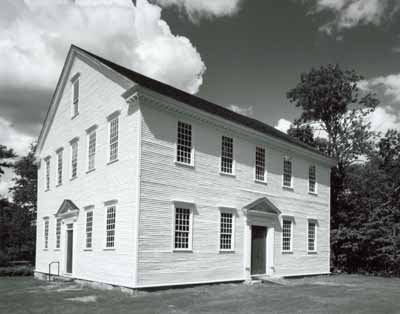
|
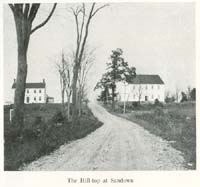 The most famous building in Sandown is its former town hall, which since 1835 has been called "The Old Meeting House."
While the town as a whole has been largely ignored by the outside world, its meetinghouse has gained a marked degree of notoriety.
Sandown is credited by many with possessing the finest meetinghouse in New Hampshire - and there are those who would go so far as to say the finest in America.
The most famous building in Sandown is its former town hall, which since 1835 has been called "The Old Meeting House."
While the town as a whole has been largely ignored by the outside world, its meetinghouse has gained a marked degree of notoriety.
Sandown is credited by many with possessing the finest meetinghouse in New Hampshire - and there are those who would go so far as to say the finest in America.
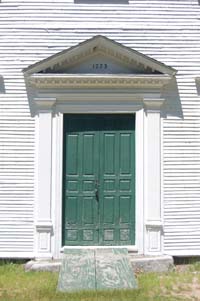 At the Old Meeting House, voters cast their ballots for every president from George Washington to Herbert Hoover.
In the hall, the men of this small town debated the merits of the new Constitution of 1787.
From its pulpit, the Word of God was amplified and explained to a believing congregation.
This building has seen the boys of Sandown march off to fight in a half dozen wars.
And it was to this Old Meeting House that a grieving town gathered again to memorialize their honored dead.
During more than two hundred years, the warp and woof of the town's history has been woven together with that of its meetinghouse to form a common fabric.
At the Old Meeting House, voters cast their ballots for every president from George Washington to Herbert Hoover.
In the hall, the men of this small town debated the merits of the new Constitution of 1787.
From its pulpit, the Word of God was amplified and explained to a believing congregation.
This building has seen the boys of Sandown march off to fight in a half dozen wars.
And it was to this Old Meeting House that a grieving town gathered again to memorialize their honored dead.
During more than two hundred years, the warp and woof of the town's history has been woven together with that of its meetinghouse to form a common fabric.
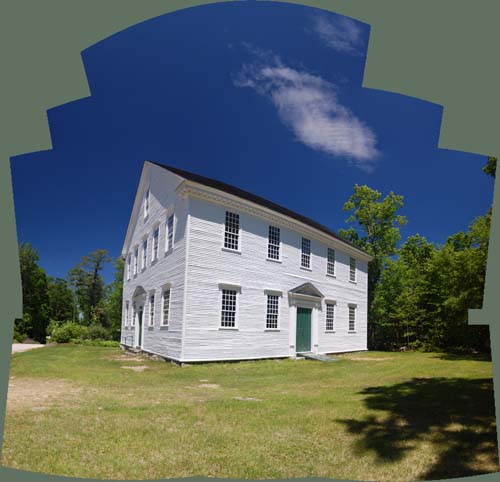 The Old Meeting House was not Sandown's first meetinghouse.
In 1772, the growing town met to debate the merits of building a new and grander meetinghouse.
Without question the primary cause for the discussion was that the old hall was just too small and crowded for a town of six hundred souls.
Likely of equal importance to the citizens was the belief that an impressive new meetinghouse would be a symbol of civic pride to present to the world.
The Old Meeting House was not Sandown's first meetinghouse.
In 1772, the growing town met to debate the merits of building a new and grander meetinghouse.
Without question the primary cause for the discussion was that the old hall was just too small and crowded for a town of six hundred souls.
Likely of equal importance to the citizens was the belief that an impressive new meetinghouse would be a symbol of civic pride to present to the world.
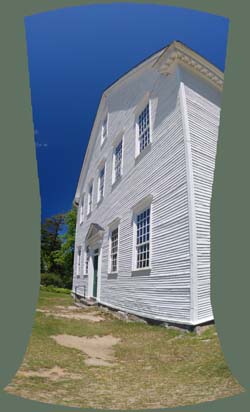 A Solomon-like solution was finally conceived:
the meetinghouse would be placed in the exact center of the town.
The town meeting of November 12, 1772, voted that Nathaniel French, Captain Nathaniel Batchelder, and Captain David Sleeper would find the geographic center.
They would start at the west end of the two-hundred-acre grants and measure from the Hampstead town line to the Fremont town line.
The actual carrying of the surveyor's chain was entrusted to church deacons Samuel Sleeper and Benjamin Tucker.
The surveyors were each paid six shillings, three pence for their labor.
A town meeting was convened on November 20, 1772, to receive the report of French, Batchelder, and Sleeper.
They reported that the center of the town was at a "stump and stone" to the south of John Colby's land.
It was on the crest of a high hill and only a few feet from Fremont Road.
This was the perfect spot for the new town hall.
A meetinghouse set on a hill cannot be hidden.
A Solomon-like solution was finally conceived:
the meetinghouse would be placed in the exact center of the town.
The town meeting of November 12, 1772, voted that Nathaniel French, Captain Nathaniel Batchelder, and Captain David Sleeper would find the geographic center.
They would start at the west end of the two-hundred-acre grants and measure from the Hampstead town line to the Fremont town line.
The actual carrying of the surveyor's chain was entrusted to church deacons Samuel Sleeper and Benjamin Tucker.
The surveyors were each paid six shillings, three pence for their labor.
A town meeting was convened on November 20, 1772, to receive the report of French, Batchelder, and Sleeper.
They reported that the center of the town was at a "stump and stone" to the south of John Colby's land.
It was on the crest of a high hill and only a few feet from Fremont Road.
This was the perfect spot for the new town hall.
A meetinghouse set on a hill cannot be hidden.
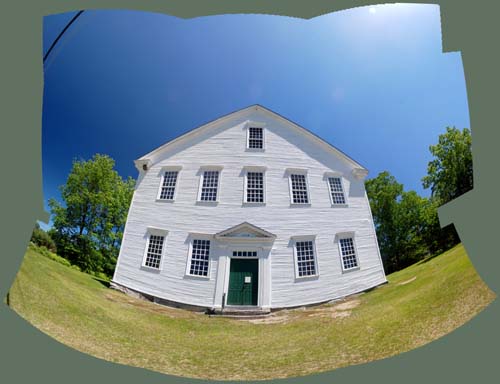 To raise funds to construct the new meetinghouse, it was voted to auction the ownership of the pews among the parishioners.
The results of the auction have not been preserved, and so we do not know which family owned which pew.
As it took a decade to pay off the builders of the Old Meeting House, it may be presumed that the 1774 auction was not overly successful in raising large amounts of cash.
To raise funds to construct the new meetinghouse, it was voted to auction the ownership of the pews among the parishioners.
The results of the auction have not been preserved, and so we do not know which family owned which pew.
As it took a decade to pay off the builders of the Old Meeting House, it may be presumed that the 1774 auction was not overly successful in raising large amounts of cash.
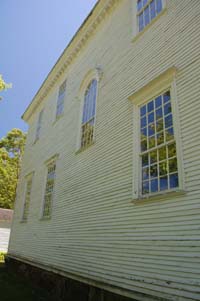 A number of plausible but unconfirmed town legends have been handed down about the construction of the meetinghouse.
One story says that in 1773-74 a search of Sandown failed to turn up enough suitable wood for the building
and that all of those fine wide pine boards and oak timbers were actually imported from upstate New Hampshire.
This tale certainly has the ring of truth.
At the time in question, the forests of Sandown had already been harvested for at least forty years.
It is likely that all the old growth oak and bull pines had already been vanquished for ships' masts and timber.
To find oak trees that could produce foot-square beams in fifty foot lengths and to find pine trees that could yield boards over two feet in width,
one would probably have to go north of Concord to the still virgin forests near the Coos Valley.
A number of plausible but unconfirmed town legends have been handed down about the construction of the meetinghouse.
One story says that in 1773-74 a search of Sandown failed to turn up enough suitable wood for the building
and that all of those fine wide pine boards and oak timbers were actually imported from upstate New Hampshire.
This tale certainly has the ring of truth.
At the time in question, the forests of Sandown had already been harvested for at least forty years.
It is likely that all the old growth oak and bull pines had already been vanquished for ships' masts and timber.
To find oak trees that could produce foot-square beams in fifty foot lengths and to find pine trees that could yield boards over two feet in width,
one would probably have to go north of Concord to the still virgin forests near the Coos Valley.
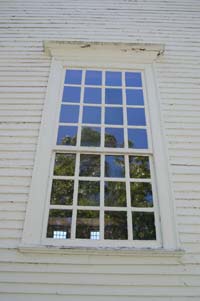 The most repeated story on the building of the Old Meeting House deals with the workmen.
A barrel of New England rum had been provided to quench the thirsts of the laborers.
Framing a building was strenuous work and spirituous liquor was perceived as a means of combating fatigue.
When a worker began to get tired, he would belly up to the barrel for a pick-me-up as was the common practice throughout all of colonial New England.
The most repeated story on the building of the Old Meeting House deals with the workmen.
A barrel of New England rum had been provided to quench the thirsts of the laborers.
Framing a building was strenuous work and spirituous liquor was perceived as a means of combating fatigue.
When a worker began to get tired, he would belly up to the barrel for a pick-me-up as was the common practice throughout all of colonial New England.
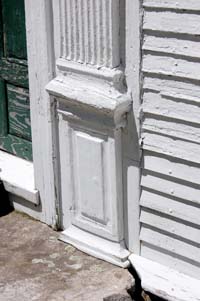 One unusual feature of the Old Meeting House was recently discovered in a crawl-through examination by local contractor Richard Drowne.
Under the floor is the complete skeleton of a pig. Was it left there as part of the dinner served to the work crew in 1774?
Did some prankster put a live pig under the floor, where it died and has been undiscovered until now?
Or was it an Old Testament-type sacrifice intended to bring the blessings of God on the town?
The foundation stones are very tight, so it is unlikely that an animal could simply stray there on its own, then or now.
Even the wood shavings put there in 1773-74 are still fresh in this crawl space.
One unusual feature of the Old Meeting House was recently discovered in a crawl-through examination by local contractor Richard Drowne.
Under the floor is the complete skeleton of a pig. Was it left there as part of the dinner served to the work crew in 1774?
Did some prankster put a live pig under the floor, where it died and has been undiscovered until now?
Or was it an Old Testament-type sacrifice intended to bring the blessings of God on the town?
The foundation stones are very tight, so it is unlikely that an animal could simply stray there on its own, then or now.
Even the wood shavings put there in 1773-74 are still fresh in this crawl space.
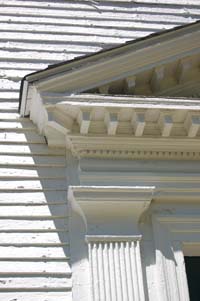 There are no stained glass windows in the old building.
The plain glass windows are there only to let in the honest, unadorned sunlight.
The designers of the meetinghouse knew that the building needed more than "spiritual light" to illuminate the worshippers,
for unlike the cold dark meetinghouses of the past, this new style of architecture bathed the interior in light.
Moreover, this warming sunlight would doubtlessly be a considerable comfort in the cold, blustery days of winter.
There are no stained glass windows in the old building.
The plain glass windows are there only to let in the honest, unadorned sunlight.
The designers of the meetinghouse knew that the building needed more than "spiritual light" to illuminate the worshippers,
for unlike the cold dark meetinghouses of the past, this new style of architecture bathed the interior in light.
Moreover, this warming sunlight would doubtlessly be a considerable comfort in the cold, blustery days of winter.
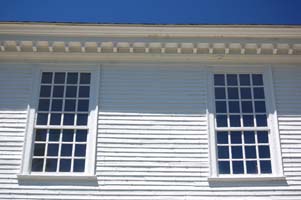 Each of the family pews have board seats that are hinged to the walls so that during the long standing times,
the worshipper could fold up the seat and lean his body against the wall.
This would certainly be a comfort during the pastoral prayer, which often required the congregation to stand for half an hour.
As soon as the prayer was over, the seats would be dropped to their normal position.
It has long been said that parishioners would slam their seat down very hard to signify their displeasure in having had to stand for so long.
The noise, it was told, was deafening.
Each of the family pews have board seats that are hinged to the walls so that during the long standing times,
the worshipper could fold up the seat and lean his body against the wall.
This would certainly be a comfort during the pastoral prayer, which often required the congregation to stand for half an hour.
As soon as the prayer was over, the seats would be dropped to their normal position.
It has long been said that parishioners would slam their seat down very hard to signify their displeasure in having had to stand for so long.
The noise, it was told, was deafening.
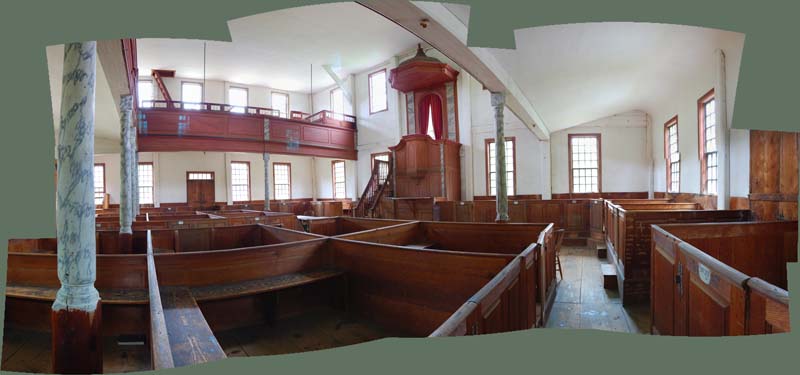 Tradition says that newly married couples would be allowed to occupy the slave pew on the Sunday following their wedding,
and it was expected that during the sermon the couple would stand on the pew seat and display their finery for the whole congregation.
The pastor was supposed to continue preaching as if nothing was happening.
Tradition says that newly married couples would be allowed to occupy the slave pew on the Sunday following their wedding,
and it was expected that during the sermon the couple would stand on the pew seat and display their finery for the whole congregation.
The pastor was supposed to continue preaching as if nothing was happening.
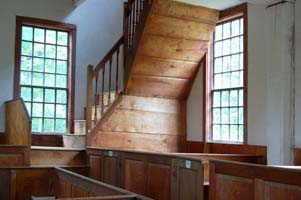 The ground floor pew to the immediate west of the pulpit was traditionally reserved for the pastor's wife and family,
and directly in front of the pulpit was the bench where the two deacons sat facing the congregation.
A folding table top of marble-painted wood covered the front of the pew.
This was where the deacons set communion and where the church members would come one at a time to deposit their tithes and offerings in full view of the rest of the congregation.
In the second pew to the west of the pulpit is a board fastened to the side of a pew.
The knife marks and knife holder tell all that this is where the communion bread was cut two hundred years ago.
The ground floor pew to the immediate west of the pulpit was traditionally reserved for the pastor's wife and family,
and directly in front of the pulpit was the bench where the two deacons sat facing the congregation.
A folding table top of marble-painted wood covered the front of the pew.
This was where the deacons set communion and where the church members would come one at a time to deposit their tithes and offerings in full view of the rest of the congregation.
In the second pew to the west of the pulpit is a board fastened to the side of a pew.
The knife marks and knife holder tell all that this is where the communion bread was cut two hundred years ago.
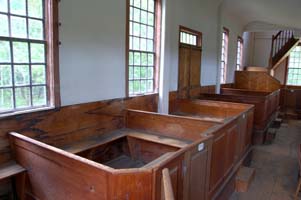 The style of this pulpit is known as a goblet pulpit, and is fairly common among the so-called "type two" meetinghouses.
Its form rather resembles the chalice used during Holy Communion.
The deacon's communion table is like the plate used to hold the element of bread during communion.
The style of this pulpit is known as a goblet pulpit, and is fairly common among the so-called "type two" meetinghouses.
Its form rather resembles the chalice used during Holy Communion.
The deacon's communion table is like the plate used to hold the element of bread during communion.
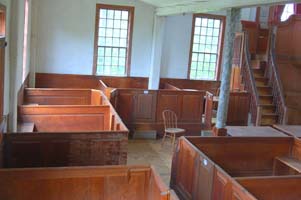 With the death of the Congregational Society after 1800, the meetinghouse was apportioned between a number of denominations.
Each body of believers were given the use of the Old Meeting House for a set number of Sundays each year.
A group of followers would hire a local or itinerant minister of like faith to preach on their turn at the pulpit.
With the death of the Congregational Society after 1800, the meetinghouse was apportioned between a number of denominations.
Each body of believers were given the use of the Old Meeting House for a set number of Sundays each year.
A group of followers would hire a local or itinerant minister of like faith to preach on their turn at the pulpit.
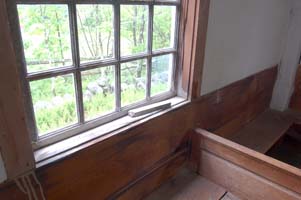 The first request for a meetinghouse stove was made at the town meeting of 1825.
It was turned down cold.
The next winter must have been a particularly harsh one because then the voters warmed up to the idea and voted to install a stove.
The story has been passed down about a female member of the anti-stove faction who put on a public display of being faint from the heat given off by the new stove.
It was later revealed that there was actually no fire in the stove at the time.
The first request for a meetinghouse stove was made at the town meeting of 1825.
It was turned down cold.
The next winter must have been a particularly harsh one because then the voters warmed up to the idea and voted to install a stove.
The story has been passed down about a female member of the anti-stove faction who put on a public display of being faint from the heat given off by the new stove.
It was later revealed that there was actually no fire in the stove at the time.
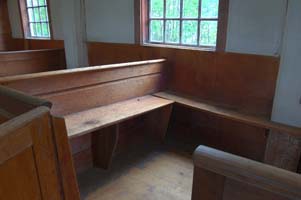 After the town moved its town meetings in 1929 from the Old Meeting House to its new town hall, the old building ceased to have any active town function.
On September 20, 1929, a group met to form The Old Meeting House Historical Association,
with the stated goal of maintaining the building for the benefit of the future residents of the town.
After the town moved its town meetings in 1929 from the Old Meeting House to its new town hall, the old building ceased to have any active town function.
On September 20, 1929, a group met to form The Old Meeting House Historical Association,
with the stated goal of maintaining the building for the benefit of the future residents of the town.